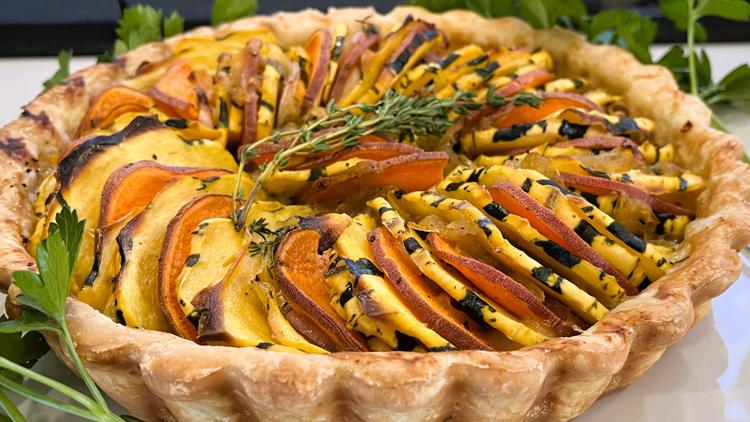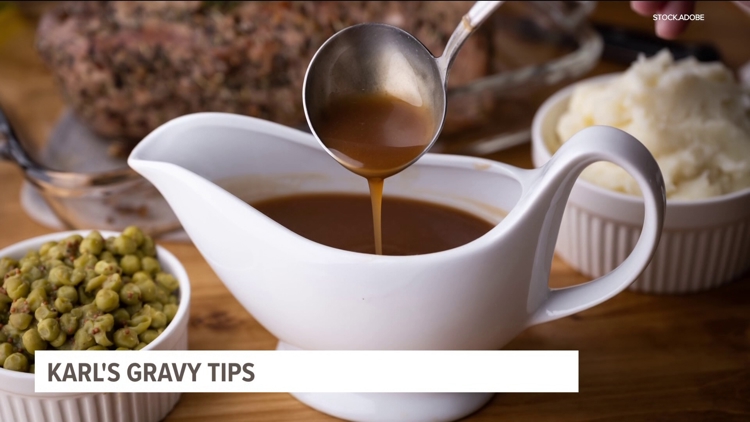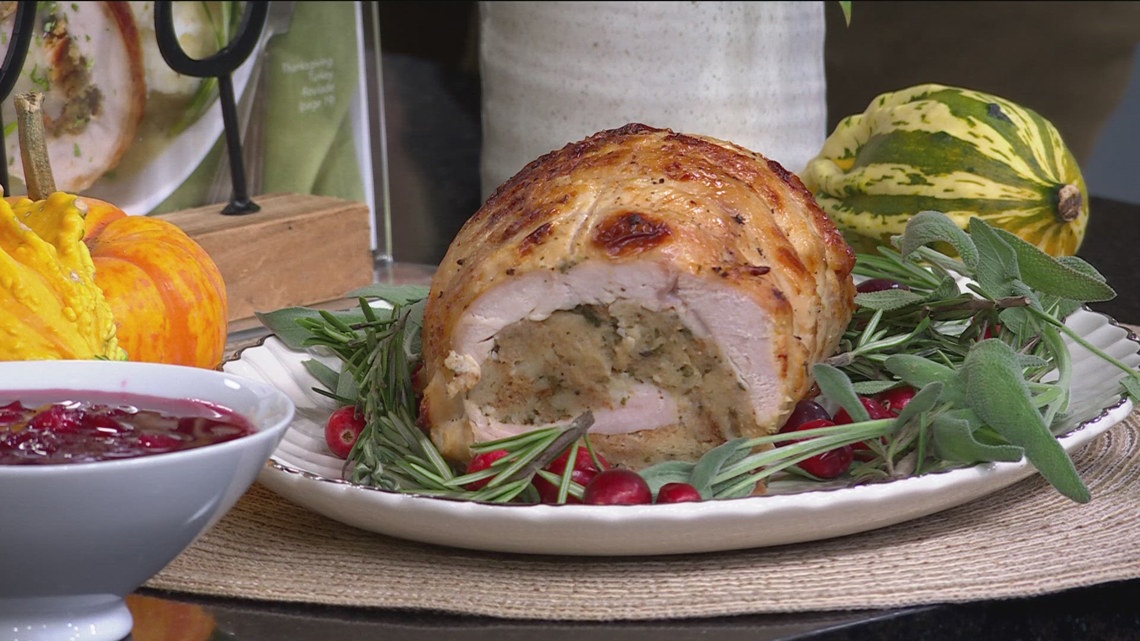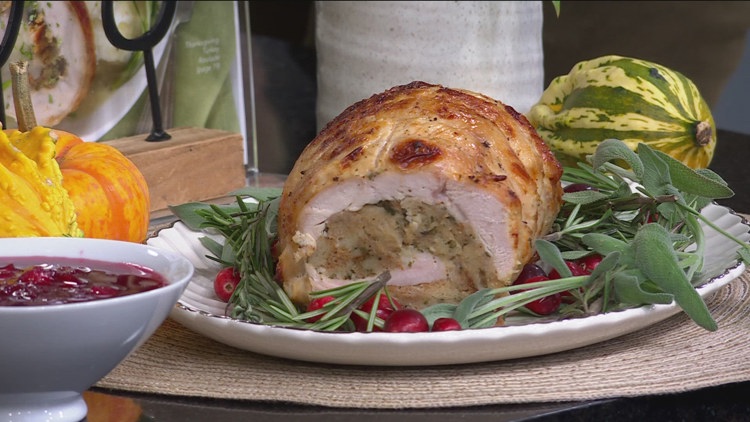Kare11
MN toddler impacted by applesauce lead poisonings


Mom Alyssa Magnuson said she was able to connect the dots after a routine blood test for Stevie came back high for lead.
MINNEAPOLIS, Minnesota — Alyssa Magnuson pays close attention to her 15-month-old daughter, Stevie Reid.
“She’s really picking up on a lot of words lately. And climbing… she’s a climber,” said Magnuson, who lives near Pine City.
So it came as a surprise when a routine blood test during Stevie’s 12-month checkup came back high for lead.
“It was a scary feeling knowing that she had that and I would have never known,” Magnuson said.
The Centers for Disease Control and Prevention uses a blood level reference value of 2.5 micrograms per deciliter to identify children with concerning blood lead levels. Stevie’s was at 23.4.
After ruling out all the usual reasons, Magnuson was confused. Then a week later, she saw the news about cinnamon applesauce and puree pouches that had been recalled due to elevated lead levels.
“It just felt horrible because it was something that I had been feeding her and I thought it was something that was going to… be a healthier option for an easy, on-the-go snack,” Magnuson said.
The recalled brands include WanaBana, Schnucks and Weis. Information on lot codes and UPCs can be found here.
Magnuson said her daughter had been eating the WanaBana Apple Cinnamon Fruit Purée pouches. She had bought them from Dollar Tree.
After realizing why her daughter tested high for lead, she went to the local Dollar Trees to make sure the affected products were off the shelves.
“My doctor thinks that we found it early enough… it’s kind of too early to tell but she thinks that she’s probably going to be just fine, thank goodness, since she didn’t have it very long-term and it was a lower level,” Magnuson said.
A facility in Ecuador is linked with the recalled pouches for its cinnamon. According to the U.S. Food and Drug Administration (FDA), samples of cinnamon from the plant contained 2,000 times more lead than what’s allowed by federal guidelines.
“No one has any idea how this got in with the cinnamon,” U.S. Sen. Amy Klobuchar (D-MN) said.
Sen. Klobuchar met with Magnuson at Children’s Minnesota on Sunday to do interviews on the issue.
“I did a baby food bill a few years ago and now we’re in the course of revamping it to make it work better for this situation,” Sen. Klobuchar said. “We’re just working on making sure the bill fits these circumstances and that there’s more oversight.”
The proposed Baby Food Safety Act of 2024 would mandate “FDA set maximum levels for heavy metals in infant and toddler food, and allows FDA to establish binding allowable levels of heavy metals for any food.” It also would create more accountability for food facility owners, operators and manufacturers by setting requirements that baby food products be sampled and tested in final product form for toxic heavy metals and the results be reported to the FDA.
Currently, most baby food manufacturers do not test their finished products and instead test only individual ingredients, according to Sen. Klobuchar’s office. It would also “clarify FDA’s mandatory recall authority over products that don’t meet standards or are rendered adulterated.”
The bill has not been introduced yet but Sen. Klobuchar expects it will be in the coming months.
In December, Sen. Klobuchar joined other lawmakers in a letter to the FDA that urged the agency to swiftly finalize its “Closer to Zero” guidance for the industry. It aims to reduce dietary exposure to contaminants to as low as possible.
“The most important thing with lead treatment is actually getting rid of the exposure and preventing it, hopefully, in the first place. Because once it’s in the body, it’s just really hard to get out,” said Dr. Abby Montague, a pediatrician and medical toxicologist at Children’s Minnesota.
Dr. Montague agreed that there need to be changes made to prevent something like this from happening again.
“Lead is a metal that we pay a lot of attention to because we know it can directly impact kids’ brains and their development. So even at low levels of lead exposure, children who have it in their blood are more likely to have learning or behavior issues later in life than a child who’s never had that exposure,” Dr. Montague said.
Dr. Montague said parents should make sure their kids are up to date on their well-child visits. If a child has consumed one of the recalled products, Dr. Montague said parents should reach out to their healthcare provider about getting tested.
Watch the latest local news from the Twin Cities and across Minnesota in our YouTube playlist:
Kare11
Squash, Caramelized Onion and Gruyere Tart from Farm at the Arb


Chef Shelagh Mullen from the Arboretum’s culinary program whipped up this seasonably wholesome dish for the KARE 11 Saturday Holiday Cooking Show.
CHASKA, Minn — Food is usually best when it goes right from the farm to the kitchen.
And that’s exactly what happens at the U of M’s Minnesota Landscape Arboretum. Chef Shelagh Mullen is at the helm of the Farm at the Arb program, where they plant, grow and harvest produce and herbs and then create seasonably wholesome fare.
Chef Shelagh invited the KARE 11 Saturday crew into her kitchen to whip up a Carmelized Onion and Gruyere Tart, perfect for Thanksgiving and the entire holiday season.
Squash, Caramelized Onion and Gruyere Tart
- 2½ cups all-purpose flour
- 2 teaspoons sugar
- 1 teaspoon kosher salt
- 1 cup unsalted butter, cold and cut into cubes
- ½ cup + 2 tablespoons ice water
- 4 tablespoons extra-virgin olive oil, divided
- 2 medium onions, very thinly sliced*
- Kosher salt
- 3 garlic cloves, thinly sliced
- 1 tablespoon Dijon mustard
- Pinch of cayenne pepper
- 4 oz. coarsely grated sharp cheddar or Gruyère
- 2 delicata squash (about 1½ lbs), halved lengthwise, seeds removed, very thinly sliced* (half moons)
- 1 small sweet potato, very thinly sliced* (half moons)
- 1 small red onion or shallot, very thinly sliced*
- 2 sprigs fresh thyme, leaves removed
- 2 tablespoons unsalted butter
- Flaky sea salt
- An 11″- or 12″-diameter fluted tart pan with removable bottom
- Mandoline or food processor (or a very sharp knife)
Place a rack in the lower third of the oven; preheat to 375°.
FILLING: Swirl 2 tablespoons of oil in a large skillet to coat bottom and add the onions; season with kosher salt. Set the skillet over medium heat and cook onions, stirring occasionally and making sure to scrape the bottom of the pan, until very soft and deep golden brown, 20-30 minutes. Add garlic and cook, stirring occasionally, until onions are caramelized and deeply browned, 5-10 more minutes (if onions get super dark and stick to the pan, a few drops of water should dislodge them). Let cool.
CRUST: Place the flour, sugar, and salt in the bowl of a food processor, fitted with the metal blade. Add the cubed cold butter and pulse a few times, until the butter is evenly mixed in and resembles peas. Slowly add the water and pulse until the dough becomes crumbly and starts to stick together. Remove the dough from the food processor and put onto a clean surface. Form the dough into a ball and cover with plastic wrap. Chill the dough for at least 2 hours in the refrigerator.
Roll out dough on a lightly floured surface to about ⅛” thick. Transfer to tart pan. Lift up the edges and allow the dough to slump down into pan, don’t stretch the dough. Gently press into corners and trim excess. Freeze until firm, 15–20 minutes, or cover and chill in the fridge for up to 12 hours.
Cut sweet potato and red onion in half lengthwise, then thinly slice crosswise with mandoline or food processor. Drizzle remaining 2 tablespoons of oil over vegetables and season with kosher salt.
Brush mustard over chilled dough, then sprinkle with cayenne (from up high, but more even distribution). Layer in the cheese, then top with the caramelized onions in an even layer.
Arrange vegetables (alternating the squash, sweet potato and red onion) in concentric circles, with rounded edges facing up, starting from the outside edge, leaning slices against the crust, and working your way inward.
Loosely cover with foil and bake tart until edges of vegetables are browned (a few spots may even get deeply browned) and crust is golden brown, 60–75 minutes. Melt thyme and butter in a small saucepan and cook just until butter is bubbling. Baste the tart with the butter and thyme mixture a few times while it bakes. Sprinkle with crunchy salt, place back in the oven, uncovered for 10-15 minutes until the crust is golden brown and veggies are soft.
*Use a mandoline, a very sharp knife, or food processor, to thinly slice squash, sweet potatoes and onions.
Kare11
Cooks | Bellecour serves up suggestions for the perfect gravy


You can tell by the quote above that Cooks|Bellecour co-owner Karl Benson does not take the responsibility of making gravy lightly. Here’s his time-tested recipe.
GOLDEN VALLEY, Minn. — It is pretty clear that Cooks | Bellecour co-owner Karl Benson does not undervalue the sides and accouterments that may not bask in the spotlight but can make or break the holiday experience.
For example, Benson calls gravy “the sauce that ties the whole (Thanksgiving) meal together.” Whether it’s topping the mashed potatoes, elevating the stuffing or adding a new dimension to a pile of turkey, a good batch of gravy can push you from zero to HERO.
Karl dropped by the KARE 11 Saturday Holiday Cooking Show for a demonstration. Take a run at this recipe to see if it’s what the doctor ordered.
Karl Benson’s Gravy
- ¼ cup turkey fat and drippings
- ½ cup all-purpose flour
- ½ cup white wine
- 4 cups of homemade turkey stock (see note)
- 5 leaves fresh sage
- 3 sprigs thyme
- 1 sprig rosemary
- Salt and pepper to taste
- 1/4 cup of whipping cream for a creamy version
- 2 tablespoons apple cider for a nuanced fall flavor
- zest of an orange for a citrus undertone
- If using the drippings after roasting a turkey, remove the turkey and place onto a resting rack or cutting board, leaving the drippings and fat in the bottom of the pan.
- If making ahead of time, use the drippings and bits from roasting the turkey bones for stock.
- In a medium saucepan or the roasting pan itself, heat fat and drippings on medium heat until simmering. While whisking constantly, sprinkle the flour over the whole bottom of the pan, making sure to scrape up anything stuck to the bottom of the pan while whisking out any flour clumps.
- Continue to cook, over medium, whisking constantly, until the flour mixture gets thicker, homogenous, and lightly browned.
- Add the white wine and continue whisking until the flour has absorbed all of the liquid.
- Begin slowly adding the stock, still stirring constantly, approximately ½ cup at a time, to make sure the mixture stays smooth. Once all of the stock has been added, add the herbs and reduce to low so it can simmer until fragrant and thick. Optionally, finish with a small amount of cream.
- Serve warm.
Kare11
RECIPE: Thanksgiving Turkey Roulade | kare11.com


Kowalski’s Culinary & Branding Director, Rachael Perron, is back at KARE 11 Saturday for the annual Thanksgiving Show to deliver a tasty dish.
GOLDEN VALLEY, Minn. — How does this sound for your Thanksgiving dinner? A boneless breast is wrapped around stuffing and rolled into a perfectly sliceable “roast” that offers the ideal stuffing-to-turkey ratio. Perfect for impressing guests, this recipe cooks faster and is easier to serve than a whole bird while still delivering a classic Thanksgiving taste in every bite.
Kowalski’s Culinary & Branding Director, Rachael Perron, is back at KARE 11 Saturday for the annual Thanksgiving Show to deliver a tasty dish.
RECIPE: Thanksgiving Turkey Roulade
- 2-3 lb. split turkey breast, deboned, butterflied and pounded to an even ¼-½” thickness (see Tasty Tip)
- kosher salt and freshly ground Kowalski’s Black Peppercorns, to taste
- 3 cups (approx.) Kowalski’s Sausage & Sage or Wild Rice & Mushroom Stuffing (from the Deli Department)
- kitchen twine
- ¼ cup (½ stick) Kowalski’s Unsalted Butter, melted
- 2 cups chicken broth
- Kowalski’s Mashed Potatoes and Kowalski’s Poultry Gravy (from the Deli Department), warmed, for serving
- chopped fresh herbs (such as rosemary, thyme and/or sage), to taste
- Preheat oven to 375°.
- Lay flattened turkey skin-side down on a cutting board, short end facing you; season liberally with salt and pepper.
- Evenly spread stuffing on turkey breast, leaving a little more than a ½” border. Starting at the end closest to you, tightly roll the turkey around the stuffing, tucking in the ends to contain the filling. Tightly tie roulade with twine 1-2 times down the length of the roll, then across the width at 1″ intervals.
- Transfer roulade to a roasting rack set in a roasting pan. Brush with about ½ of the melted butter; season liberally with salt and pepper. Pour broth into the bottom of the pan.
- Roast roulade until internal temperature reaches 150° (50-60 min.), brushing with remaining butter about halfway through; increase temperature to 400° in the last 10 min. to crisp and darken the skin, if desired.
- Remove roulade from oven; let rest on the rack for 15 min. (internal temperature will increase to 165° during this rest period).
- Remove twine; slice roulade crosswise into ½” slices.
- Serve over mashed potatoes; drizzle with gravy and garnish with herbs.
Ask one of our butchers to debone and butterfly your turkey breast* or do it yourself, like so:
Remove the bone from the turkey breast. Lay the turkey breast flat on a cutting board, skin side down, with the shortest side facing you. Keeping a knife parallel to the board, use short strokes to carefully slice the breast in half horizontally, stopping about ¾” before reaching the left side. Open the turkey breast like a book. To flatten, cover it with plastic wrap; starting in the center, use a rolling pin or meat mallet to pound the breast to an even ¼-½” thickness, being careful not to rip through the turkey.
* Please allow 24 hrs. notice during busy periods.




